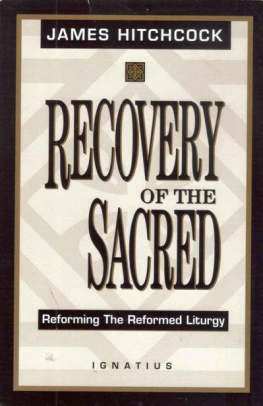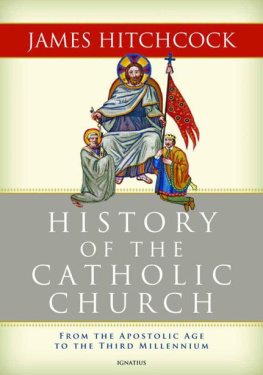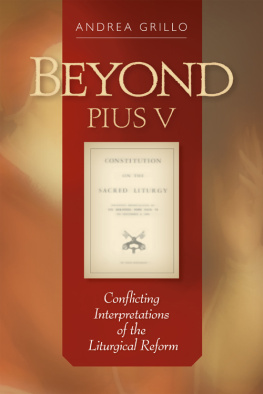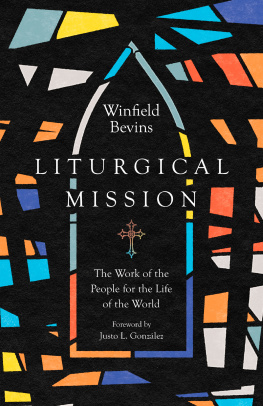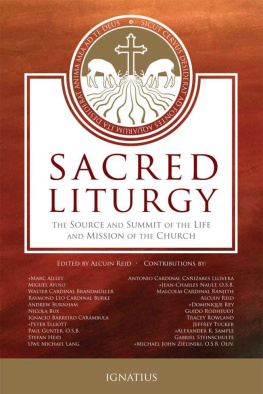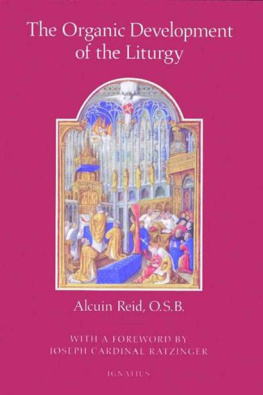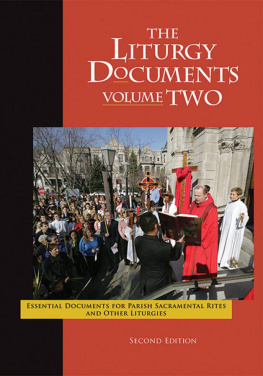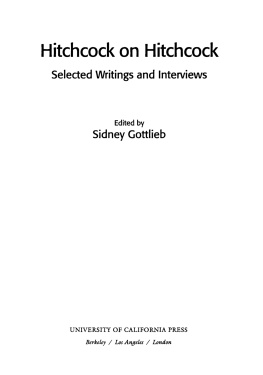Recovery of the Sacred
James Hitchcock
The Recovery of the Sacred
IGNATIUS PRESS SAN FRANCISCO
Original edition 1974 The Seabury Press, Inc.
All rights reserved.
Cover by Riz Boncan Marsella
Reprinted in 1995 by Ignatius Press
ISBN 978-0-89870-544-7
Library of Congress catalogue number 94-75662
Printed in the United States of America
For My Parents
Contents
Preface
This is a book the author wishes would never have to be reprinted. It was first written less than a decade after the Second Vatican Council to call attention to certain liturgical trends which seemed unwise and even destructive. But the book had no perceptible effect on the course of liturgical development, so that the analysis remains as relevant today as it was more than twenty years ago. Authors ego aside, this is a symptom of a much greater problemthe apparent determination by professional liturgists to pay heed only to other certified experts. For thirty years every warning about liturgical abuse has automatically been dismissed as uninformed.
As the book demonstrates, the Liturgical Movement (no longer capitalized once it had been absorbed into the mainstream of Catholic life) turned sharply leftward immediately after the Council, so that some of its pioneers, such as Msgr. Martin B. Hellriegel (see the Preface to the first edition) were quickly estranged from the movement they had labored so long to bring to fruition. (Before Msgr. Hellriegel died in 1981, the author had several candid conversations with him in which Americas greatest pastoral liturgist expressed his deep disappointment at the post-conciliar developments.)
The classical (pre-1965) Liturgical Movement, despite being considered vaguely liberal, sought something both very difficult and very simpleto deepen peoples knowledge and appreciation of the inexhaustible mystery of the liturgy and hence of the Church itself. It sought to elevate the practice of liturgy as it then existed in order to incorporate neglected riches of earlier centuries, especially the Patristic age.
Whether before the Council some liturgists were already impatient with that purpose remains a matter of speculation. What is undeniable is that the classical program of liturgical reform was abandoned very swiftly. Instead of seeking deeper understanding of the great tradition of the Church through the ages, liturgists now sought relevance by means of continued adaptation to contemporary culture.
Probably most Catholics now like the new liturgy and would not wish to return to the old. Although both the revived Tridentine Mass and solemn celebrations of the Novus Ordo are deeply moving to many people, suburban American culture has had its effect, so that for perhaps a majority the regimen of guitar songs, casual styles of celebration, and churches almost as bare as meeting halls are considered signs of progress. Personal preference is not the issue, however. Despite the original purposes of the Liturgical Movement, Catholics today are badly instructed concerning the fundamental meaning of the liturgy and even indifferent to its meaningit is a communal celebration in which they feel they should take part, but it is hardly a crucial part of their lives. People like the present liturgy precisely because they are oblivious to the spiritual riches which liturgy embodies.
When this book was written, the fundamental causes of liturgical distortion were not yet clear, although there were many clues scattered about waiting to be deciphered. It is by now apparent that the deformation of the liturgy stems from the denial of human sinfulness, from a semi-conscious popular Pelagianism in which people think of themselves as wholly good.
The steep decline in the practice of confession, which is linked to the Eucharist in an intimate way and one of the Churchs basic rites, is merely the most obvious sign of this, along with the preference of many celebrants to omit the Confiteor , for example.
For reasons which are still obscure, the modern Western psyche cannot endure the thought of being under judgment, of having all ones thoughts and actions definitively summed up by the Supreme Judge. To maintain what they regard as a healthy self-esteem, modern Christians excuse most transgressions, define sin in terms like failure to grow, and shut out even the possibility of divine punishment.
This explains the sometimes hysterical reaction of liberal Catholics when confronted with even the idea of traditional worship, much less the experience of it. For authentic Catholic liturgy is always transcendent and other. Worshipers speak almost exclusively to God, not to each other, and their worship is filled with expressions of their own unworthiness and Gods infinite greatness. (Thus the Gloria is also often omitted from modern celebrations.) Traditional solemn Masses affected worshipers with a sense of awe, of personal insignificance before the Almighty, and even routinely celebrated low Masses took place in an atmosphere of hushed reverence, of timidity about entering the holy place. (One of the major faults of the Novus Ordo is the fact that it has no rite whereby the priest approaches the altar unworthily, and prepares himself to ascend its steps, as was done in the traditional prayers at the foot of the altar.)
The aim of post-conciliar liturgical change, whether or not fully conscious, has been to make liturgy quite obviously a human creation, a mere extension of the self. God is not found except in the depths of ones own soul or in encounters with other human beings, and God is revealed in any experience which the individual subjectively feels is meaningful.
Thus the ideal post-conciliar liturgy, seldom fully realized in parish churches but often achieved in other kinds of communities, is one in which the texts of the rite are chosen and even composed by the worshipers, in which the priest is not a divine ambassador but simply the representative of the community, in which the physical setting is mundane and familiar, and the style of celebration is elaborately relaxed. The homily is a dialogue, since no authoritative word should be spoken by the priest, as though instructing or admonishing the congregation.
Such celebrations are apt expressions of certain kinds of modern theology, but even for those innocent of all theology they are satisfying because they do not threaten. One never hears the voice of God in a clap of thunder, is never raised on high, has no sense that Christ has come down on the altar. Worshipers never have to ask themselves, Am I worthy?
The state of liturgy in many parishes is unsatisfactory because often those charged with preparing it strain to produce this kind of atmosphere despite the fact that the objective structure of the liturgy thwarts it at every point. Despite what some conservative critics of the Novus Ordo claim, it is an irreformably vertical rite, attested to by the fact that for many people the high point of the Mass is now a moment not even provided for in the official rubricsthe greeting of peacewhich by the logic of recent liturgical assumptions ought to replace the Communion as the climax of the Mass.
Since the Council the practice of having the celebrant face the congregation has been studied more carefully, and the claim that it represents the practice of the early Church has been disprovenin the early centuries the celebrant and the congregation both faced the East at the high moments of the Mass, looking towards the rising sun, symbol of the Risen Christ who will come again. Although once again most people now probably like having celebrant and people face one another, it has proven to be an anomalous practice which tends to reduce the celebration to a communal gathering.
But the cultural situation at the end of the second Christian millennium, while obviously inhospitable to religion in many ways, is in others perhaps potentially more supportive of genuine liturgical renewal than was the immediate era of the Council.
Next page
